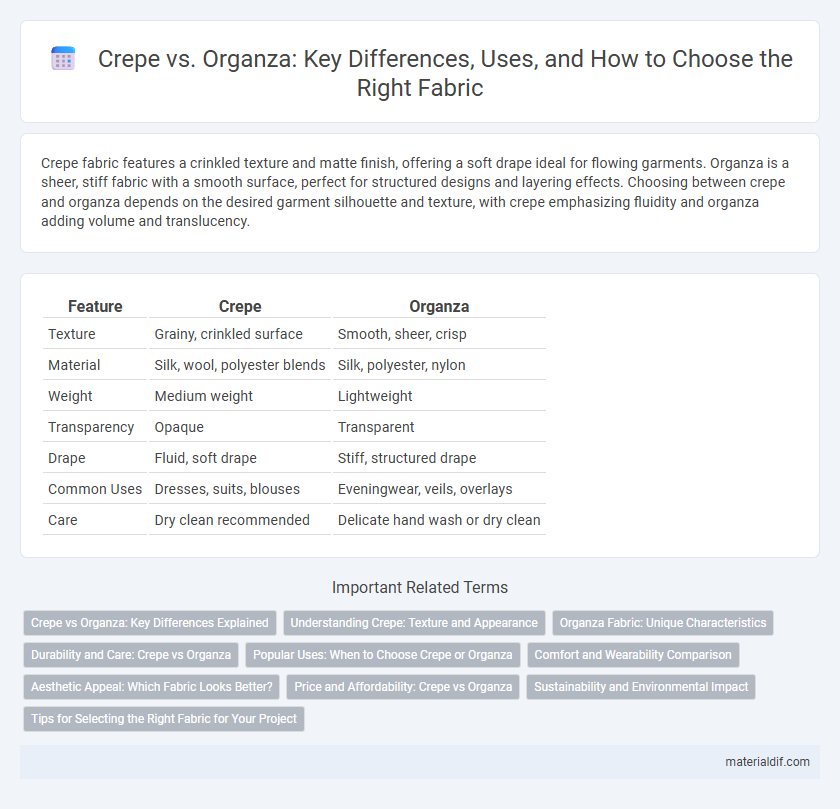Crepe fabric features a crinkled texture and matte finish, offering a soft drape ideal for flowing garments. Organza is a sheer, stiff fabric with a smooth surface, perfect for structured designs and layering effects. Choosing between crepe and organza depends on the desired garment silhouette and texture, with crepe emphasizing fluidity and organza adding volume and translucency.
Table of Comparison
| Feature | Crepe | Organza |
|---|---|---|
| Texture | Grainy, crinkled surface | Smooth, sheer, crisp |
| Material | Silk, wool, polyester blends | Silk, polyester, nylon |
| Weight | Medium weight | Lightweight |
| Transparency | Opaque | Transparent |
| Drape | Fluid, soft drape | Stiff, structured drape |
| Common Uses | Dresses, suits, blouses | Eveningwear, veils, overlays |
| Care | Dry clean recommended | Delicate hand wash or dry clean |
Crepe vs Organza: Key Differences Explained
Crepe fabric is known for its slightly crinkled texture and matte finish, offering excellent drape and softness, making it ideal for dresses and blouses. Organza, a sheer and crisp fabric made from silk or synthetic fibers, provides structure and volume, commonly used in bridalwear and evening gowns. Crepe emphasizes fluidity and comfort, while organza delivers stiffness and a translucent appearance, highlighting their distinct functional and aesthetic differences.
Understanding Crepe: Texture and Appearance
Crepe fabric features a distinctively crinkled, grainy texture achieved through highly twisted yarns, giving it a slightly rough yet elegant surface that drapes beautifully. Its matte finish and fluidity make crepe ideal for garments requiring structure with softness, such as dresses and blouses. The textured appearance sets crepe apart from smooth, sheer materials like organza, offering more opacity and subtle depth in fabric design.
Organza Fabric: Unique Characteristics
Organza fabric is distinguished by its lightweight, sheer texture and crisp hand, making it popular for elegant evening wear and bridal gowns. Its unique stiffness allows it to hold shapes well, providing volume without heavy weight, which contrasts with the more fluid nature of crepe. This fabric is typically made from silk or synthetic fibers like polyester, offering a translucent effect that adds a delicate, ethereal quality to garments.
Durability and Care: Crepe vs Organza
Crepe fabric offers higher durability and resists wrinkles, making it ideal for garments requiring frequent wear and easy maintenance. Organza, being delicate and sheer, demands gentle handling and specialized care to prevent snags and tearing. Proper washing and storage extend the lifespan of both fabrics, but crepe's resilience makes it more practical for everyday use.
Popular Uses: When to Choose Crepe or Organza
Crepe fabric is ideal for draped garments such as dresses, blouses, and suits due to its textured surface and fluid fall, providing a sophisticated yet comfortable fit. Organza is often chosen for formalwear, bridal gowns, and evening dresses where a crisp structure and sheer, lightweight appearance enhance the garment's elegance. Selecting crepe favors versatility and movement, while organza is perfect for designs requiring volume and a delicate, translucent effect.
Comfort and Wearability Comparison
Crepe fabric offers superior comfort due to its lightweight, breathable nature and slight stretch, making it ideal for all-day wear. Organza, while visually stunning with its crisp, sheer texture, tends to be stiffer and less breathable, which can reduce comfort during extended use. For garments requiring flexibility and ease of movement, crepe is often preferred over organza because of its soft drape and wearability.
Aesthetic Appeal: Which Fabric Looks Better?
Crepe fabric offers a textured, matte finish with a graceful drape that enhances sophisticated, understated elegance, making it ideal for formalwear and evening dresses. Organza, on the other hand, is sheer and crisp with a shimmering surface, creating a voluminous, ethereal look often favored in bridal gowns and high-fashion designs. The choice between crepe and organza depends on the desired aesthetic: crepe emphasizes smooth flow and subtlety, while organza highlights lightness and structural brilliance.
Price and Affordability: Crepe vs Organza
Crepe fabric generally offers greater affordability compared to organza, with prices often 20-30% lower due to simpler weaving techniques and widely available raw materials. Organza, known for its sheer, stiff texture, commands higher prices because of its delicate manufacturing process and the use of finer fibers like silk. Budget-conscious buyers typically prefer crepe for everyday wear, while organza is reserved for special occasions where luxury and visual impact justify the elevated cost.
Sustainability and Environmental Impact
Crepe fabric is often made from natural fibers like silk or wool, which are biodegradable and have a lower environmental impact compared to synthetic alternatives. Organza, frequently produced from synthetic fibers such as polyester or nylon, tends to have a higher carbon footprint and contributes to microplastic pollution during washing. Choosing crepe from sustainable sources supports eco-friendly fashion by reducing chemical use and promoting renewable materials in the textile industry.
Tips for Selecting the Right Fabric for Your Project
Choose crepe for garments requiring fluid drape and subtle texture, as its matte finish and stretch properties enhance comfort and movement. Opt for organza when a crisp, sheer fabric with a shimmering surface is needed, ideal for structured designs and overlays. Consider the project's purpose, desired fabric weight, transparency, and ease of sewing to ensure optimal performance and aesthetic appeal.
Crepe vs Organza Infographic

 materialdif.com
materialdif.com